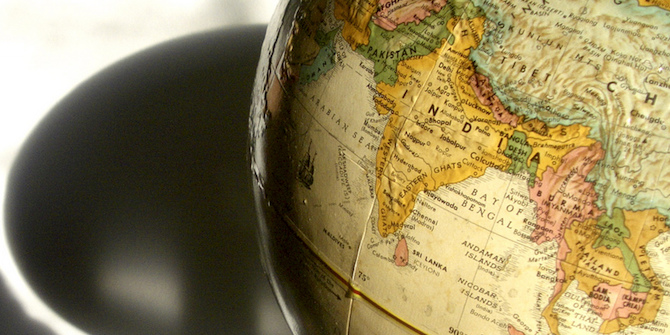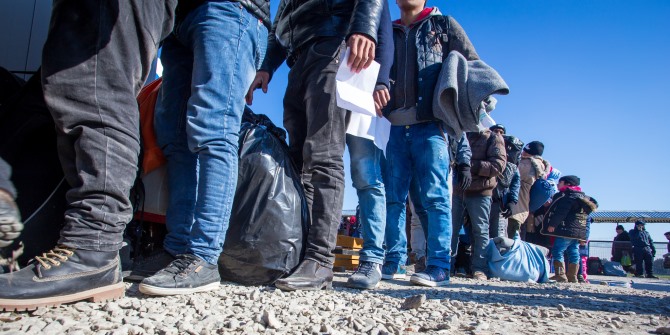 The evidence suggests that changing age-old traditions and social attitudes requires more than legal reforms and guidelines. Sangita Thebe Limbu looks at the issue of stigma around menstruation with particular reference to Nepal and highlights the wide ranging impacts which make it both a pressing human rights and development issue. She writes that a two-pronged approach which aims to break the taboo creatively and enable good menstrual hygiene is key to progress.
The evidence suggests that changing age-old traditions and social attitudes requires more than legal reforms and guidelines. Sangita Thebe Limbu looks at the issue of stigma around menstruation with particular reference to Nepal and highlights the wide ranging impacts which make it both a pressing human rights and development issue. She writes that a two-pronged approach which aims to break the taboo creatively and enable good menstrual hygiene is key to progress.
Menstruation is a natural biological process experienced by a majority of women and girls of reproductive age. Yet the symbolism and practices surrounding this recurring natural event differs across cultures. In some contexts, it is rendered socially invisible shrouded in privacy and largely concealed. In others, particularly where menstruation is much more interlinked with day-to-day religious rituals, it becomes visible and more stigmatised. But beyond these differences, underpinned by various religious, cultural and gendered norms on bodies, purity and propriety - there is a commonality. And that is menstruation is predominantly labelled as taboo. In some extreme cases this menstrual stigma can manifest in the loss of lives.
The tradition of Chhaupadi
The Chhaupadi practice prevalent in far and mid-western regions of Nepal is a stark example of the detrimental impacts of menstrual stigma. Chhaupadi is based on the notions of purity and pollution that form the basis of the caste system, including gender relations, in Hindu culture. In this traditional practice, menstruating women and girls are considered ‘polluted’, ‘impure’ and ‘untouchable’. They are denied entry to houses, kitchens and temples; and at night they have to sleep outside their homes often in animal sheds. They are barred from using public water sources; and are not allowed to touch men, children, cattle, living plants, or fruit bearing trees. They cannot consume milk products, and are not allowed to participate in religious and social activities. Superstitions run deep as violations of this traditional practice are expected to incite misfortunes such as death, disease, crop failures and water shortages.
On December 2016, 15-year-old Roshani Tiruwa from Nepal’s Achham district was found dead in a tiny menstrual hut. She lit a fire to keep herself warm before going to sleep and died of suffocation due to smoke. This news was preceded by the death of 26-year-old Dambara Upadhyay from the same district in November, who also died in an isolated shed, although the exact cause of death was unidentified. Snake bites, wild animal attacks, suffocation from smoke, and sexual harassment and abuse are often reported as threats that many menstruating women and girls face when they are exiled from their homes.
The Chhaupadi system was outlawed by the Supreme Court of Nepal in 2005, and in 2008 the Ministry of Women, Child and Social Welfare promulgated guidelines to eradicate Chhaupadi nationally. However, a 2011 UN report estimated that about 95% of women practiced it in Achham district. More recent and accurate data is hard to find at both district and national level, but this staggeringly high figure alone goes on to show that changing age-old tradition and social attitudes requires more than legal reforms and guidelines.
Impacts of menstrual stigma
It is worth noting that cultural beliefs and practices surrounding menstruation are not homogenous across Nepal. Various other factors such as caste, ethnicity, religion and geographical region influence the nature and degree of stigmatisation. However, a 2009 WaterAid study in central and eastern regions of Nepal, involving 204 adolescent girls in both urban-rural settings, showed that about 89% of the survey respondents practiced some form of menstrual restriction or exclusion, the most common one being abstaining from religious activities.
The impacts of menstrual stigma compounded with poor menstrual hygiene are multifaceted – they hinder equal and meaningful participation of women and girls in various educational, social, cultural and economic activities and perpetuate the cycle of gender inequality and social exclusion. For example, menstruation affects school attainment with 30% of girls missing schools during periods in Nepal, often due to physical pain, limited infrastructure (lack of separate/private toilets, door locks, running water, sanitary pads disposal facilities), mental stress (embarrassment from potential leakage), and social custom. Some Hindu groups in Nepal practice the custom of gupha basne in which a girl’s first period is marked by seclusion in a dark room for up to 12 days.
Poor menstrual hygiene (due to limited access to water and re-using cloths that have not been adequately washed and dried) also results in reproductive health problems such as urinary tract infection, vaginal scabies and abnormal discharge. Other well-being problems arise from internalised feelings of shame (and untouchability). Creating a safe and enabling environment for women and girls to manage their menstruation hygienically, and with dignity is therefore an important development and human rights agenda, but how can that be achieved?
Breaking silence, creatively
Breaking the taboo on talking about periods is the first step, with interventions required in both schools and communities. It is important to educate both girls and boys on why and how period happens. It is not enough for menstruation to be featured in school curriculum, attention must also be paid to how and whether the curriculum is being taught at all. Of equal importance is to provide accessible information at the right age.

According to WaterAid’s 2009 study in Nepal, only 17.2% of respondents said that they were informed about menstruation before their first periods by teachers, while mothers and sisters were cited as the primary source of information. The study further highlights that many teachers avoided reproductive health topics, prescribing self-study instead. Another research study, conducted in Kathmandu, shows that participants learnt about menstruation in school curriculum towards the end of secondary school (age groups 15-16) but many had already started their periods so the information they received was informative but not very useful in dealing with practicalities.
One of the ‘best practice’ examples in addressing cultural stigma on teaching about menstruation and lack of age appropriate materials is Menstrupedia. It provides informative and entertaining guides on periods in the form of comic books for young students, supplemented by trainers’ guide for teachers with interactive content and lesson plans. There are also student-led initiatives encouraging young people to speak more openly about periods such as the haiku contest on menstruation organised by medical students in southern state of India.
Positive messaging can also take the form of art. For example, Beauty in Blood – a collection of art work featuring menstrual blood, challenges the stigma of menstruation in a subtle, artistic and reflective manner. The takeaway message from these examples is that challenging the discourse around menstrual taboos can be done in creative ways and they might be more effective in opening discussion between girls and boys, and society at large.
“Please buy me a sanitary napkin.”
“I can’t, Mom… I am a boy.”
But what he forgot,
He wouldn’t have born if she had never bled
(Abhijith Vellat, one of the submissions from the Haiku contest)
Cultural caveats
Working with young people is important as they can be agents for change, but the stronghold of culture and age-old social practices cannot be underestimated. Both WaterAid’s 2009 study and another study conducted among female residents of Kathmandu valley shows that a majority of women maintained the belief that menstruation is a normal and natural biological process. Yet, the majority of them also observed menstrual restrictions and exclusionary practices often accepted on the grounds of long-standing tradition and societal pressure.
That said, participants did mention that they would reduce or eliminate some of those practices when it comes to their own daughters. These findings show that any form of interventions should go beyond individual level and focus on holistic, collective and long-term efforts to challenge adverse social norms and attitudes. This could involve normalising positive views of monthly periods through mass media, supporting grassroot organisations and collective initiatives, working with religious and community leaders, and promoting social role models and champions.
Promoting menstrual hygiene
Addressing menstrual stigma is important but it should go hand-in-hand with provision of basic infrastructure and resources that enable women and girls to manage their monthly periods. It is estimated that only 45% of schools have adequate toilets in least developed and low-income countries. In Nepal only 36% of schools have a separate toilet for girls. Hence, provision of separate toilets with door locks, running water, soaps, sanitary pad disposable facilities and waste management should be taken into account in Water, Sanitation and Hygiene interventions.
Access to affordable sanitary pads is equally important. There are various innovative initiatives such as AFRIpads in Uganda that locally produces cost-effective and re-usable sanitary pads. A pad production machine developed in India has resulted in establishment of over 2,100 local pad production centres across the country, largely set up by women’s cooperatives and rural non-profits. Those centres produce and sell low-cost sanitary pads locally. Furthermore, World Menstrual Hygiene Day on 28 May, introduced for the very first time in 2014, is also a positive step – enabling the momentum and progress in menstrual hygiene and awareness.
Research gaps
In this article, menstruation is largely discussed in relation to women and girls, which is also reflective of the wider development and medical discourse around the topic. However, menstruation is also a reality for many trans- and intersex people and more research is required to bring out nuanced understanding of menstrual experiences. Contemporary research on menstrual stigma is studied from the perspective of either reproductive health, impact on education or WASH. But what is missing is a more joined up approach and further socio-economic analysis on the issue, with a recognition that menstrual stigma and taboos are manifestations of wider gender and social relations.
She loved biology.
Wanted to be a doctor.
Then biology took over.
She never saw school again.
(Athira Unni – Source: the Guardian)
This article gives the views of the author, and not the position of the South Asia @ LSE blog, nor of the London School of Economics. Please read our comments policy before posting.
About the Author
 Sangita Thebe Limbu recently completed her Masters in Gender, Development and Globalisation at LSE. She is a regular contributor to South Asia @ LSE, you can view her previous posts here.
Sangita Thebe Limbu recently completed her Masters in Gender, Development and Globalisation at LSE. She is a regular contributor to South Asia @ LSE, you can view her previous posts here.








Menstruation is like a natural filteration system that has unfortunately been guised as impurity by the society. When nature is hard to understand then social becomes the norm. It is thus ,the need of hour to advertise the science of nature in a similar way as public opinion is modified by political advertisements.